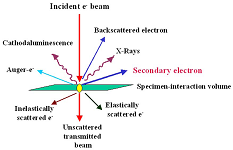
Asia Pacific Academy of Science Pte. Ltd. (APACSCI) specializes in international journal publishing. APACSCI adopts the open access publishing model and provides an important communication bridge for academic groups whose interest fields include engineering, technology, medicine, computer, mathematics, agriculture and forestry, and environment.

Immunoanalytical approaches for the control of xenobiotics and biotoxins in foodstuffs
Vol 4, Issue 2, 2023
Download PDF
Abstract
Effective control of food quality and safety requires analytical methods that guarantee the reliable determination of any substance potentially harmful to the consumer that may be present in the food prior to its distribution and marketing. One of the analytical approaches that contributes to guarantee this objective encompasses a series of techniques that have in common the use of antibodies as essential elements for the detection of the target analyte, and which together are called immunochemical methods. This article aims to provide a basic overview of the biochemical principles underlying these technologies and their advantages and limitations in the determination of chemical contaminants, residues and additives in food matrices. The last part discusses some of our initiatives in this field that have resulted in commercially available rapid kits after transferring the corresponding technology to the industrial sector.
Keywords
References
- Landsteiner K, Simms S. Production Of Heterogenetic Antibodies With Mixtures Of The Binding Part Of The Antigen And Protein. Journal of Experimental Medicine. 1923; 38(2): 127-138. doi: 10.1084/jem.38.2.127
- Abad-Fuentes A, Esteve-Turrillas FA, Agulló C, et al. Development of competitive enzyme-linked immunosorbent assays for boscalid determination in fruit juices. Food Chemistry. 2012; 135(1): 276-284. doi: 10.1016/j.foodchem.2012.04.090
- Mercader JV, Agulló C, Abad-Somovilla A, et al. Synthesis of site-heterologous haptens for high-affinity anti- pyraclostrobin antibody generation. Organic & Biomolecular Chemistry. 2011; 9(5): 1443. doi: 10.1039/c0ob00686f
- Vallejo RP, Bogus ER, Mumma RO. Effects of hapten structure and bridging groups on antisera specificity in parathion immunoassay development. Journal of Agricultural and Food Chemistry. 1982; 30(3): 572-580. doi: 10.1021/jf00111a040
- Sanvicens N, Pichon V, Hennion MC, et al. Preparation of Antibodies and Development of an Enzyme-Linked Immunosorbent Assay for Determination of Dealkylated Hydroxytriazines. Journal of Agricultural and Food Chemistry. 2002; 51(1): 156-164. doi: 10.1021/jf025640v
- López-Puertollano D, Mercader JV, Agulló C, et al. Novel hapten and monoclonal antibodies with subnanomolar affinity for a classical analytical target, ochratoxin A. Scientific Reports. 2018; 8(1): 9761. doi: 10.1038/s41598- 018-28138-x
- Parra J, Mercader JV, Agulló C, et al. Generation of anti-azoxystrobin monoclonal antibodies from regioisomeric haptens functionalized at selected sites and development of indirect competitive immunoassays. Analytica Chimica Acta. 2012; 715: 105-112. doi: 10.1016/j.aca.2011.12.014
- Suárez-Pantaleón C, Mercader JV, Agulló C, et al. Forchlorfenuron-mimicking haptens: from immunogen design to antibody characterization by hierarchical clustering analysis. Organic & Biomolecular Chemistry. 2011; 9(13): 4863. doi: 10.1039/c1ob05190c
- Montalbetti CAGN, Falque V. Amide bond formation and peptide coupling. Tetrahedron. 2005; 61(46): 10827- 10852. doi: 10.1016/j.tet.2005.08.031
- Esteve-Turrillas FA, Parra J, Abad-Fuentes A, et al. Hapten synthesis, monoclonal antibody generation, and development of competitive immunoassays for the analysis of picoxystrobin in beer. Analytica Chimica Acta. 2010; 682(1-2): 93-103. doi: 10.1016/j.aca.2010.09.042
- Esteve-Turrillas FA, Abad-Somovilla A, Quiñones-Reyes G, et al. Monoclonal antibody-based immunoassays for cyprodinil residue analysis in QuEChERS-based fruit extracts. Food Chemistry. 2015; 187: 530-536. doi: 10.1016/j.foodchem.2015.04.119
- Ramón-Azcón J, Sánchez-Baeza F, Sanvicens N, Marco MP. Development of an enzyme-linked immunosorbent assay for determination of the miticide bromopropylate. Journal of Agricultural and Food Chemistry. 2009; 57(2): 375-384. doi: 10.1021/jf802821n
- González-Techera A, Varell L, Last JA, et al. Phage anti-immune complex assay: General strategy for non- competitive immunodetection of small molecules. Analytical Chemistry. 2007; 79(20): 7799-7806. doi: 10.1021/ac071323h
- López-Moreno R, Mercader JV, Agulló C, et al. Immunoassays for trifloxystrobin analysis. Part I. Rational design of regioisomeric haptens and production of monoclonal antibodies. Food Chemistry. 2014; 152: 230-236. doi: 10.1016/j.foodchem.2013.11.150
- Suárez-Pantaleón C, Mercader JV, Agulló C, et al. Production and Characterization of Monoclonal and Polyclonal Antibodies to Forchlorfenuron. Journal of Agricultural and Food Chemistry. 2008; 56(23): 11122-11131. doi: 10.1021/jf802261x
- Esteve-Turrillas FA, Mercader JV, Agulló C, et al. Moiety and linker site heterologies for highly sensitive immunoanalysis of cyprodinil in fermented alcoholic drinks. Food Control. 2015; 50: 393-400. doi: 10.1016/j.foodcont.2014.09.023
Supporting Agencies
Copyright (c) 2023 Josep V. Mercader, Antonio Abad-Somovilla Abad-Somovilla, Consuelo Agulló, Antonio Abad-Fuentes

This work is licensed under a Creative Commons Attribution 4.0 International License.

This site is licensed under a Creative Commons Attribution 4.0 International License (CC BY 4.0).
1.jpg)
Prof. Sivanesan Subramanian
Anna University, India





.jpg)
